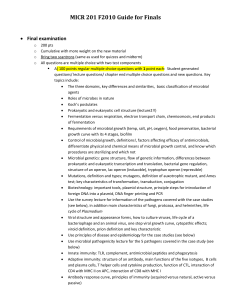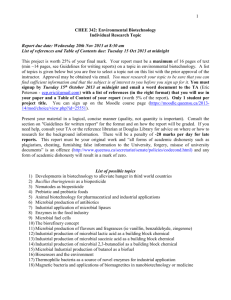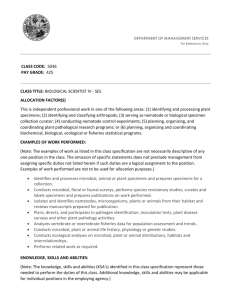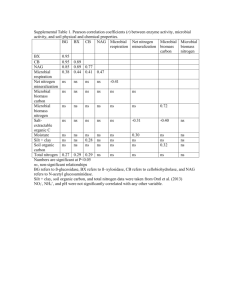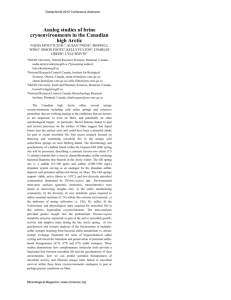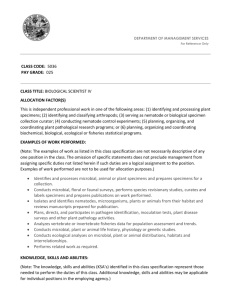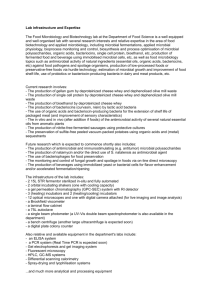MB 420/520 Microbial Genomics
advertisement
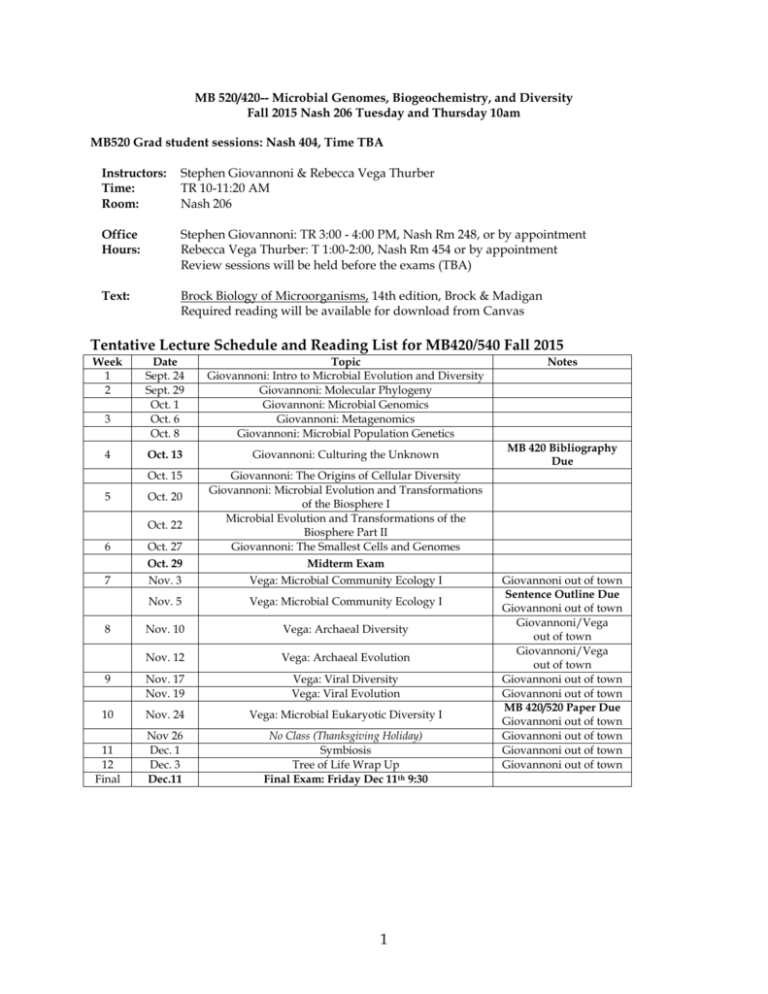
MB 520/420-- Microbial Genomes, Biogeochemistry, and Diversity
Fall 2015 Nash 206 Tuesday and Thursday 10am
MB520 Grad student sessions: Nash 404, Time TBA
Instructors:
Time:
Room:
Stephen Giovannoni & Rebecca Vega Thurber
TR 10-11:20 AM
Nash 206
Office
Hours:
Stephen Giovannoni: TR 3:00 - 4:00 PM, Nash Rm 248, or by appointment
Rebecca Vega Thurber: T 1:00-2:00, Nash Rm 454 or by appointment
Review sessions will be held before the exams (TBA)
Text:
Brock Biology of Microorganisms, 14th edition, Brock & Madigan
Required reading will be available for download from Canvas
Tentative Lecture Schedule and Reading List for MB420/540 Fall 2015
Week
1
2
Date
Sept. 24
Sept. 29
Oct. 1
Oct. 6
Oct. 8
Topic
Giovannoni: Intro to Microbial Evolution and Diversity
Giovannoni: Molecular Phylogeny
Giovannoni: Microbial Genomics
Giovannoni: Metagenomics
Giovannoni: Microbial Population Genetics
Oct. 13
Giovannoni: Culturing the Unknown
Oct. 15
Oct. 27
Oct. 29
Nov. 3
Giovannoni: The Origins of Cellular Diversity
Giovannoni: Microbial Evolution and Transformations
of the Biosphere I
Microbial Evolution and Transformations of the
Biosphere Part II
Giovannoni: The Smallest Cells and Genomes
Midterm Exam
Vega: Microbial Community Ecology I
Nov. 5
Vega: Microbial Community Ecology I
Nov. 10
Vega: Archaeal Diversity
Nov. 12
Vega: Archaeal Evolution
9
Nov. 17
Nov. 19
Vega: Viral Diversity
Vega: Viral Evolution
10
Nov. 24
Vega: Microbial Eukaryotic Diversity I
11
12
Final
Nov 26
Dec. 1
Dec. 3
Dec.11
No Class (Thanksgiving Holiday)
Symbiosis
Tree of Life Wrap Up
Final Exam: Friday Dec 11th 9:30
3
4
5
Oct. 20
Oct. 22
6
7
8
1
Notes
MB 420 Bibliography
Due
Giovannoni out of town
Sentence Outline Due
Giovannoni out of town
Giovannoni/Vega
out of town
Giovannoni/Vega
out of town
Giovannoni out of town
Giovannoni out of town
MB 420/520 Paper Due
Giovannoni out of town
Giovannoni out of town
Giovannoni out of town
Giovannoni out of town
Course Description: Microbial diversity from the earliest life forms to the modern role of bacteria and
archaea in biogeochemical cycles. The evolution of microbial proteins, genomes and metabolic pathways
shaped global transitions in Earth ecology. On this backdrop students are introduced to key concepts in
molecular evolution, bioinformatics, genomics and metagenomics. Particular emphasis is placed on
marine systems, from photosynthesis in surface waters to life in the ocean crust. Some examples of topics
covered include: the evolution of photosynthesis; a geo-historical perspective on the global carbon cycle
and its relevance to modern issues such as the ocean fertilization controversy and hypoxia; the origins of
the major domains of life; a genomic perspective on the simplest cells; microbial life in the deep
subsurface (the earth's crust). This course is designed for upper division undergraduates and beginning
graduate students who have taken upper division biochemistry and molecular biology courses
Pre-requisites: BB450, BB451.
Course Policies: Grades will be based on assignments (400 points possible) including: annotated
bibliography (25 points), sentence outline (25 points), one midterm (100 points), a paper (100 points) and a
final exam (150 points). The final exam is semi-cumulative. The exams will cover the materials presented
in lecture and the assigned reading material. The final exam will be inclusive. Grades will be assigned
according to the percentage of the total possible points obtained: 95-100%, A; 91-94%, A-; 87-90%, B+; 8386%, B; 79-82%, B-; 75-78%, C+, 71-74%, C; 67-70%, C-; 63-66%, D+; 59-62%, D; 55-58%, D-; less than 55%,
fail. To take into account variation in the difficulty of exams, 100% will be defined as the average of the
highest three scores obtained. Makeup exams will be available to those with documented medical
excuses or other documented emergencies. All makeup exams will have written essay and interview
components.
MB520: There will also be discussion sessions held at a separate time (TBA) for 520 students, at which
discussions of key papers will be presented by the graduate students. Exams for MB520 include
additional written questions. These questions may be attempted for extra credit by undergraduate
students enrolled in MB420. Extra-credit obtained in this manner can be used to shift a grade upwards by
0.66 on a 0 - 4.0 scale, e.g. from B- to B+. Getting one extra credit question correct cancels out getting one
wrong, in another words, 5 out of 10 points is no extra credit. So, only attempt the extra credit questions
if you know your stuff, not to try your luck.
University and Departmental Policies: "Students with documented disabilities who may need
accommodations, who have any emergency medical information the instructor should know, or who need
special arrangements in the event of evacuation, should make an appointment with the instructor as early
as possible, no later that the first week of the term. In order to arrange alternative testing, the student
should make the request at least one week in advance of the test. Students seeking accommodations
should be registered with the Office of Services for Students with Disabilities."
Please note: The Department of Microbiology follows the university rules on civility and honesty. These
can be found at http://oregonstate.edu/admin/stucon/achon.htm. Behaviors disruptive to the learning
environment will not be tolerated and will be referred to the Office of Student Conduct for disciplinary
action. Cheating or plagiarism by students is subject to the disciplinary process outlined in the Student
Conduct Regulations.
Learning Outcomes (420): Acquire and retain basic knowledge about the procedures used to identify
microorganisms for environmental, medical, and industrial microbiology, and the principles used for
microbial classification. Acquire and retain basic knowledge about the different microbial groups
recognized by microbial systematics, and their phenotypic, genetic and biochemical properties.
Demonstrate ability to analyze problems that involve the above information and concepts and to reach
the correct conclusion. Demonstrate the ability to analyze an original research paper from the field and
communicate scientific concepts clearly and concisely in writing.
2
Learning Outcomes (520): In addition to the above learning outcomes, students taking MB520 are
expected to display a comprehension of advanced concepts that are exemplified in scientific literature
assigned as reading. Comprehension is displayed by written answers to problems that require an
understanding of experimental results and theories and their application to new situations.
Important Dates:
Oct. 13 ........................................................................ Bibliography Due
Oct. 29 ......................................................................... Approximate date of midterm
Nov. 5 ......................................................................... Sentence Outline Due
Nov. 24 ....................................................................... Term Paper Due, 10 AM in class
Dec. 11 (Friday) ......................................................... Final Exam; 9:30 AM, Nash 206
Lecture Outline
Reading
I. Intro to Microbial Evolution and Diversity
Overview of linkage between microbial evolution and
geochemistry
The carbon cycle and the end of the Carboniferous Period
Microbial diversity and systematics
II. Molecular Phylogeny
Models for molecular evolution
Phylogenetic trees
The evolution of gene families
Ribosomal RNA (rRNA)
The Tree of Life
III. Microbial Genomics
Genome complexity
Genome sequencing
Identifying genes and their functions
Metabolic maps
Horizontal gene transfer and comparative microbial genomics
IV. Metagenomics
The Uncultured Microbial Majority
Iron Mountain and the Sargasso Sea
Modern practice in metagenomics
Single cell genome sequencing
V. Population Genetics
Clonal theory
Natural selection and genome evolution
Selfish operons
The species concept in microbiology
VI. Culturing the Unknown
Why are some cells hard to culture?
The perfect grad student
Microbial interactions
Ch. 12.1-12.5, 12.8-12.10
Ch.27.4
Recommended:
Floudas, 2012
Recommended: Appendix 2
Ch. 12.4-12.5
VII. Origins of Cell Diversity
Ch. 2.1-12.3
3
Ch. 6
Ch. 10-5-10.8
Ch. 18.3-18.7
Ch. 12.6-12.7
Ch. 18.1-18.2
Ch. 13.10
Ch. 15.16
The origins of life and models for early cell evolution
The domains of life
Chemolithotrophy in the deep oceans
The controversy about Eukaryotic origins
Mitochondrial origins
The curious case of planctomycete nucleus-like regions
VIII. Microbial Evolution and Transformations of the Biosphere Part I
The earliest microbial fossils
Early forms of photosynthesis
Rising Oxygen at the Archean/Proterozoic Boundary
IX. Microbial Evolution and Transformations of the Biosphere Part II
Hypoxic Proterozoic Oceans
Ocean fertilization and modern ocean hypoxia
X. The Smallest Cells and the Smallest Genomes
Minimal genomes
Synthetic biology
Oct 29
Ch. 13.6-13.9
Ch. 12.1-12.2
Ch. 13.1-13.5
Recommended:
Johnston, 2009
Ch. 19.9- 19.10
Ch. 13.16-13.21
Ch. 2.6
Ch. 11.6-11.7
Midterm Exam
XI: Microbial Community Ecology I
Evaluations of Community Structure & Function
Measures of Diversity
XII: Microbial Community Ecology II
Drivers of Diversity (top down versus bottom up)
Trophic Dynamics
XIII. The Archaea (lecture by TBA)
Archaeal structural and molecular biology
Diversity: Euryarcheoata and the TACK superphylum
XIV. Archaeal II (lecture by Andrew Thurber)
Distinction from eukaryotes & bacteria
Archaeal metabolisms
XV. Viral Diversity
Viral Diversity
Viral Infection Basics
Replication and Effects on Host
XVI. Viral Diversity
Viral Evolution
Quasi-species concepts in virology
Paleovirology
XVII. Microbial Eukaryotes
Identifying eukaryotic microbial diversity
Functional groups of eukaryotic microbes
Biogeochemical cycling and microbial eukaryotes
XVIII. Evolution of Symbioses
Types of microbial symbioses
Evolution of symbioses
XVI. Tree of Life and Class Wrap Up
4
Ch. 18, 19.
Ch. 18,19.
Ch. 16
DeLong, 1992
Ch. 16
Ch. 8,9
Rohwer & Vega Thurber
2009
Ch. 8,9
Legendre et al., 2015
Ch. 17.
del Campo et al 2014
Ch 22.
Konopka 2009
MB 420/520 TERM PAPER:
Sequencing Environmentally Important Genomes
Fall 2015
The short term paper is due on Tuesday, Nov. 24th, by 10:00 am. For this paper undergraduates must
complete 2 milestones to prepare for the paper, an annotated bibliography and a sentence outline. These
milestones give us the chance to give you feedback about the appropriateness of your choice of topic and
the papers you have chosen to review as well as your overall plan for the paper.
*Note MB 520 students do not need to complete the annotated bibliography or sentence outline.
MB 420 Paper Assessment Details (150 points total)
Annotated Bibliography (25 points, October 13th)
You should gather the sources that you will use to write your paper. You must have at least five
sources (5 pts. each). Those sources can include information from peer-reviewed journals, books, and
websites (internet sources cannot include Wikipedia or other encyclopedia based websites). Three of
these sources must be from primary literature (peer-reviewed journals from the last 5 years, one of
which is the paper reporting the genome).
You should provide the complete reference for each source.
A 1-3 sentence summary paragraph about each article including what pertinent information
you will use.
A brief critique of each article. The brief critique is your appraisal. For example, "This is a
significant paper because it showed for the first time that................, which is important
because......................." or "findings reported in this paper are interesting but need to be
confirmed with other strains...........before they can be generalized", or "the methods used in
the study have limitations, which were described by ......et al (citation). Future workers may
need to apply ........ or .......... {techniques} to confirm the results."
Sentence Outline (25 points, November 5th)
You should provide a brief outline of you paper. This outline should be written in complete
sentences and should include all major sections of the report. The outline should be approximately 2
pages in length.
Final Paper (100 points, November 24th)
The paper should be at least 5 pages and not exceed 6 double spaced pages
The term paper should focus on a microorganism (bacteria or archaea) that has had a paper
published on its genome in the last 3 years
Your term paper should address the following points
o When the organism was first discovered.
o What the classification of the organism is.
o Where this organism is found.
o What the metabolism of the organism is.
o Why the genome was sequenced.
o What technologies were used to sequence.
o What new information the genome uncovered.
o What new questions the genome uncovered.
o What future experiments should be done.
5
MB 520
Final Paper (150 points, November 24th)
The paper should be 8-10 pages in length
The term paper can focus on an organisms and its genome sequence or on a broader topic in
microbial diversity.
Grading will be based on the originality of the student's paper and ideas, the thoroughness of scholarly
references to the literature, the quality of the writing and formatting of the term paper, and the accuracy
and insight of the student's understanding.
To begin preparing for the term paper, we recommend you examine the following journals: Nature,
Science, Environmental Microbiology, mBio, Journal of Bacteriology, Plos One.
6

